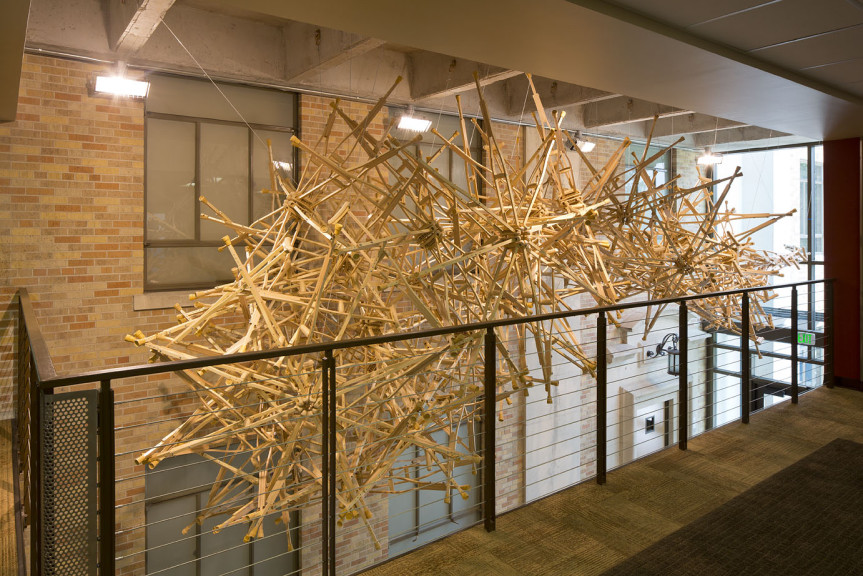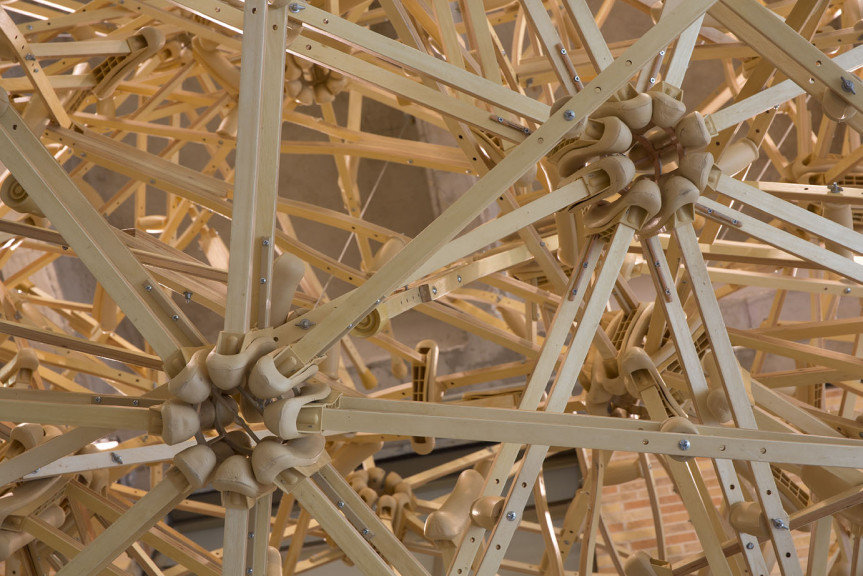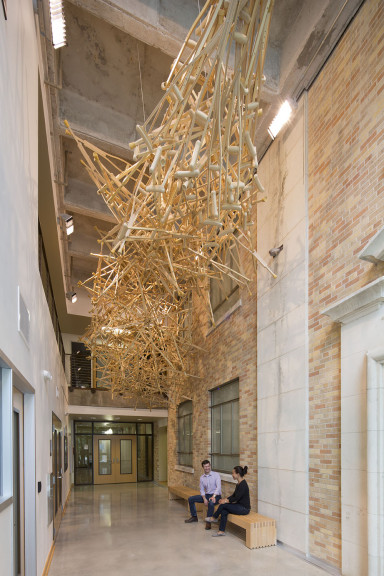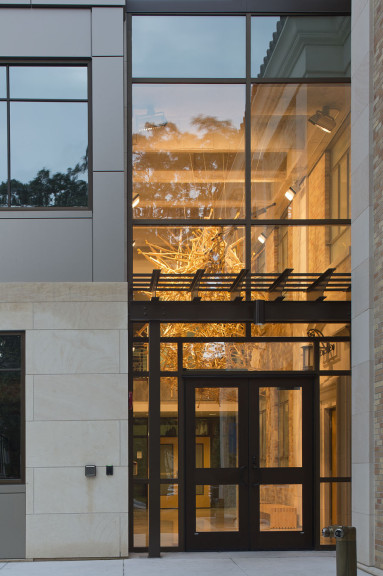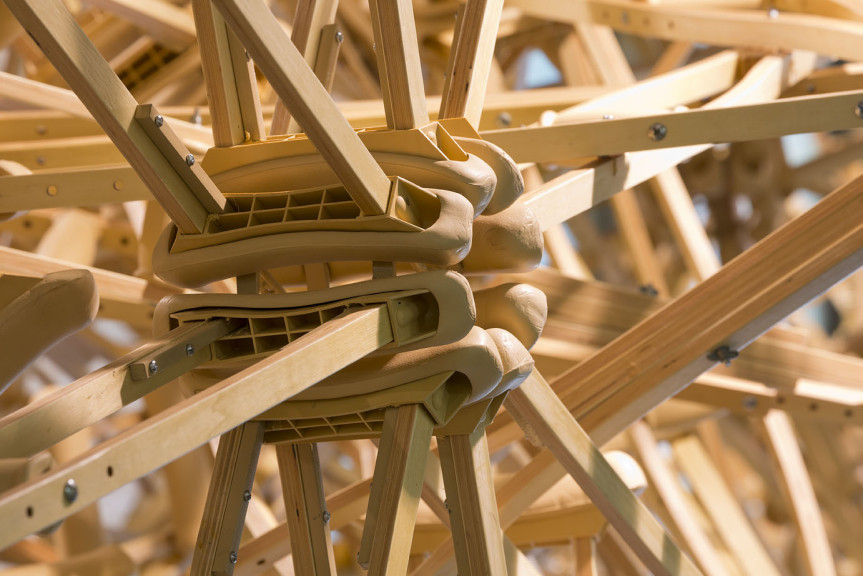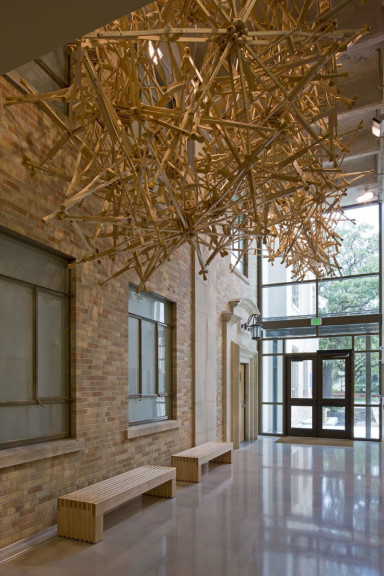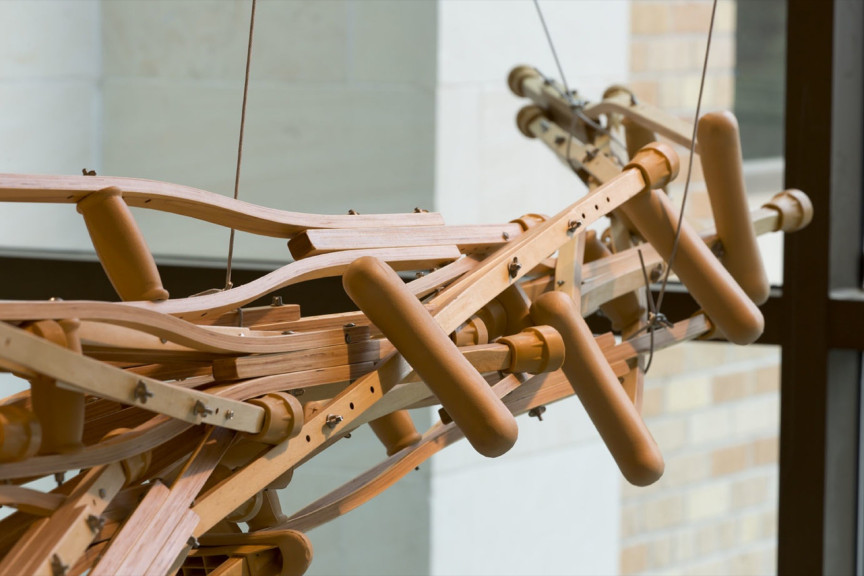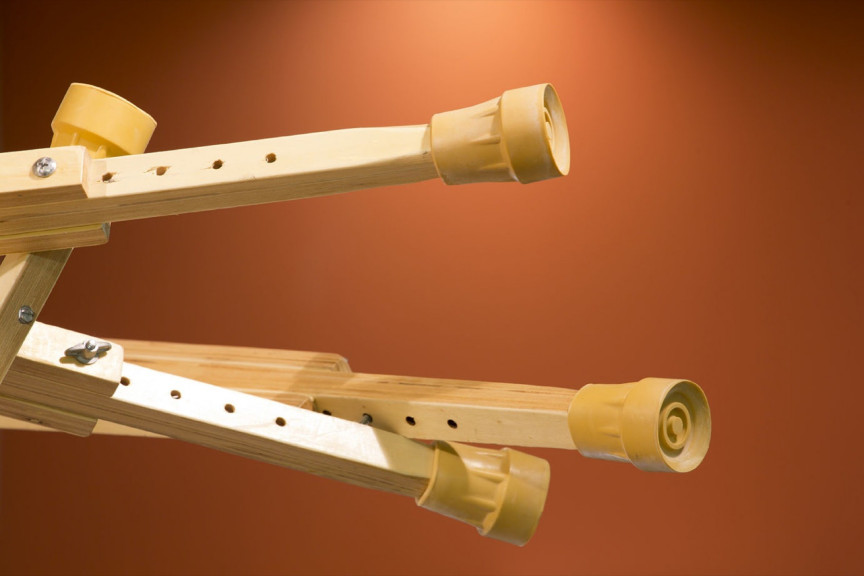(Forever Free) Ideas, Languages and Conversations
Michael Ray Charles
155 x 412 x 125 inches
Commission, Landmarks, The University of Texas at Austin, 2015
GPS: 30.287975, -97.740116
Michael Ray Charles was born in Lafayette, Louisiana, when the nonviolent Civil Rights Movement was giving way to riotous social and cultural upheaval. Like artists Kara Walker (born 1969) and Fred Wilson (born 1954), Charles explores African and African American oppression and prejudice. He is best known for work that appropriates derogatory images in order to disparage racist stereotypes. For (Forever Free) Ideas, Languages and Conversations, Charles departs from this mode and takes a more metaphorical approach, explaining, “Conceptual and representational applications of power throughout visual cultures past and present have been among my most significant triggers of creative inspiration.”
(Forever Free) Ideas, Languages and Conversations is suspended in the atrium of the Gordon-White Building, home to centers that study the history and experience of minority cultures. Charles selected the location because it joins a classic 1952 university building to a newly constructed addition used by students and scholars of the historically marginalized. In designing the atrium’s interior, the artist preserved architectural ornaments from the original building and kept rough, exposed surfaces to create a meaningful segue into the polished departmental offices. The result is both sculpture and site — a symbolic transition between the inherited establishment and a future that explores new ways of thinking and being.
Charles’ sculpture is made from wooden crutches assembled in groups to create star-shaped wheels. The individual parts maintain their own trajectory yet form a common mass in an energetic composition. When imagining the project, Charles was partly inspired by the activity of scholars who study minority cultures and the challenges they face in academic institutions. Now the centerpiece of a thriving enterprise that champions multiculturalism, (Forever Free) Ideas, Languages and Conversations is emblematic of institutional progress and transformation. By claiming the wounds of the past and acknowledging the support needed to heal, it recognizes all who have suffered inequality and carries the promise of hope and growth.
ACTIVITY GUIDES
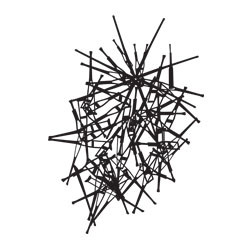
(Forever Free) Ideas, Languages and Conversations
Michael Ray Charles
Subject: Repeating Patterns
Activity: Make a pattern with rubber stamps
Materials: Rubber stamps, color inkpads, paper
Vocabulary: Pattern, shape
Patterns are used to create designs. Stripes on a t-shirt or square windows on a building are examples of patterns. Look around and see if you can find a pattern.
Sometimes artists use only one shape to create a large work of art. Michael Ray Charles made this sculpture using only wooden crutches. He bolted the crutches together then hung them from the ceiling.
What shapes do you see?
What patterns do you see? How are they made?
How many crutches make up a wheel?
Can you find the single crutches?
Make a pattern with a rubber stamp. Try stamping several repeating rows, or stamp in a circle. Use different inks to make it colorful! How many different patterns can you make?
Michael Ray Charles formed the star shapes to look like spokes on a wheel.
Pattern - A repeating line, shape, or color
Space - A circle, square, triangle, or any other type of form

(Forever Free) Ideas, Languages and Conversations
Michael Ray Charles
Subject: Mobile Madness!
Activity: Use pictures and drawings to create a mobile
Materials: Wire hanger, string, scissors, hole punch, construction paper or cardboard, pictures from magazines or materials for drawing
Vocabulary: Mobile, balance, harmony
Michael Ray Charles created 26 star-shaped wheels out of crutches and hung them from the ceiling using cables. Crutches are used to help people walk when they are injured. In this sculpture, they form wheels, which, like those on a car or bike, help people move forward.
What words would you use to describe this sculpture?
How would you describe the lines and the shapes?
If you could make a sculpture out of anything, what would you choose and why?
Decide on a theme for your mobile; it could be anything like animals, family, or sports. Draw pictures or cut out some from a magazine. Glue a piece of construction paper or cardboard to the back of your picture if it needs added support. Punch a hole at the top of your picture and loop and tie a string through the hole. Once you have all your pictures, decide the best way to display them on your hanger. Make some strings longer than others to create an interesting mobile. Don’t leave any too long or too short. Tie the other end of the strings to the hanger. Hang your mobile on a doorframe or a fan and watch it sway in the breeze!
Look closely at the sculpture. Can you see how it is held together and how it is hung from the ceiling?
Mobile - A sculpture that is suspended and moves freely in the air
Balance - An arrangement of shapes and colors where no part is more important than another
Harmony - An arrangement of shapes and colors where each component relates and complements one another
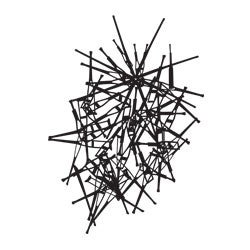
(Forever Free) Ideas, Languages and Conversations
Michael Ray Charles
Subject: Poetry and sculpture
Activity: Write a poem inspired by (Forever Free) Ideas, Languages and Conversations
Materials: Index cards, pencil or pen
Vocabulary: Diversity, culture, poetry
This building houses institutions such as the African and African Diaspora Studies Department, the Center for Mexican American Studies, and the Center for Urban Policy Research and Analysis. The artist, Michael Ray Charles, created (Forever Free) Ideas, Languages and Conversations to address the struggles endured by minority cultures. He uses crutches to symbolize support, healing, and mobility. They represent the coming together of many parts to celebrate diversity and multiculturalism.
How would you describe this sculpture to a person who has never seen it?
Why do you think the artist chose to use crutches?
Have you ever felt like you didn’t belong or that you were different from the crowd?
What can you do to make people feel included?
Take 5–10 minutes to think about the sculpture and the students who use this building. What are three words or phrases that come to mind? Write each one down on an index card and place the cards on the ground. Look at what others wrote and pick up three cards that you nd inspiring. Write a short poem using your friend’s words or phrases. Remember, poems don’t have to rhyme!
You can do this exercise alone by using your own index cards for inspiration!
The title of this sculpture is (Forever Free) Ideas, Languages and Conversations. Each crutch represents an idea or a letter. When they come together, just in a poem, they form a language and a conversation. Why do you think the artist gave his sculpture this title?
Diversity - The state of having people of different races or ethnicities in a group
Culture - A group of people that has shared beliefs, customs, and ways of living
Poetry - A type of writing in which special care is given to expressing feelings and ideas
MORE INFORMATION
(Forever Free) Ideas, Languages and Conversations is Michael Ray Charles’ project for the newly expanded and renovated Gordon-White Building at The University of Texas at Austin. The building is home to the various academic entities committed to the study of historically marginalized cultural and world histories, including the African and African Diaspora Studies Department, the John L. Warfield Center for African and African American Studies, the Institute for Urban Policy Research and Analysis, the Center for Mexican American Studies, and the Department of Mexican American and Latina/o Studies. In making the sculpture, the artist, who taught at the university for twenty-one years until 2014, reflected on the challenges of minority communities in bringing their experiences from the neglected margins to recognition at the center of academic life. Through its presence in this space, the work engages directly with the difficulties that scholars of a broader and more inclusive American history, life, and culture have endured in order to pursue their intellectual interests.
(Forever Free) Ideas, Languages and Conversations is primarily made from crutches bundled in groups to create interconnected, star-shaped forms that hover in the building’s atrium. While familiar as medical devices commonly used to aid people who have been injured, in this context the crutches become complex symbols that engage issues of harmony and conflict.
The location of the work within the Gordon-White Building is key to its meaning. The space of the atrium in which it hangs was created by connecting an original, neoclassical 1952 building with a new wing designed to accommodate several academic centers and departments. Viewing the space as a transition between the old guard and the new, both architectural and academic, Charles contributed to the renovation and expansion by selecting finishes such as a raw concrete floor and exposed ceilings to convey ideas of growth and evolution. The artist acknowledges that in any attempt to grow, whether architectural or intellectual, there may be wounds and complex historical perspectives with which each generation must engage. His careful architectural considerations within the Gordon-White atrium create an environment that becomes a part of the work. In this setting, (Forever Free) Ideas, Languages and Conversations points to that which is known and unknown—the presence of the past within the current moment.
Beyond responding to the architecture, the sculpture evokes varied associations through the star forms that are created by the clustered crutches. These symbols suggest the “Black Star” logo of the African and African Diaspora Studies Department, which in turn recalls the Black Star Shipping Line founded by the early twentieth-century visionary Marcus Garvey and the iconic Lone Star of the state of Texas. Further, each of the twenty-six stars corresponds to a different letter of the alphabet, pointing to the crucial role that language, the word, and literature have played in the history of African American culture and activism. Language and its power were key to the genesis of Black studies departments around the nation, beginning with the first proposal for such a department at San Francisco State University in 1968, just a year after Charles’ birth. As the literary historian and cultural critic Henry Louis Gates Jr. noted in a celebrated New York Times editorial, in order to have Black studies within the academy, the establishment of an African American literary canon during the 1970s and ‘80s was vital. Such programs achieved success in part by excavating archives and republishing numerous out-of-print narratives by formerly enslaved people, works of fiction by their descendants, and volumes of poetry. All of them helped established area-specific fields of study within the pre-existing disciplines of English and comparative literature.
Despite facing many challenges since its founding, the university’s African and African Diaspora Studies Department has become one of the top of its kind in the United States. It had modest beginnings that eventually produced a series of ambitious goals resulting in important achievements, such as establishing a nationally ranked PhD program 2009. Charles credits the department’s success to the vision of its chair, Dr. Edmund T. Gordon, as well as its dedicated faculty and affiliates. In light of this institutional history, Charles sees the artistic transformation of the crutches as underscoring the African and African Diaspora Studies Department’s resourcefulness and highlighting the ability of its faculty to “make-do” and “make better.”
Michael Ray Charles was born in 1967, just as the non-violent Civil Rights Movement was giving way to the rise of the Black Power Movement, signaling a shift in how many African Americans saw themselves within the unequal structures of the white male-dominated power that controlled the country’s economic and political engines. While many discussions of the artist’s work have focused on his arresting paintings that include stereotypically racist representations of black bodies, less has been written about his overarching interest in the material objects he collects and studies. They include early American chromolithography, nineteenth-century sheet music, and American and European advertisements from the late nineteenth century to the present that document the evolution of black representation within a global consumer culture.
Charles’ practice of challenging conventions with the use of found materials is not unlike that of the twentieth-century Dadaist and conceptual artist Marcel Duchamp whose influential work, Fountain, was a urinal he had purchased from a local plumbing store and provocatively entered into an art exhibition in 1917. Like Duchamp, Charles looks to the evolving nature of language and material objects to inform his work. The artifacts he collects are available in their original forms and in reproduction at antique shops and from dealers; amidst the bric-a-brac of flea markets, swap meets, and yard and garage sales; through myriad online auction and commerce sites such as EBay; and at novelty stores around the world. His interest in material manifestations of racism extends into his practice as an artist and professor of art. “The source of my work comes from my love for information, sociology and creative culture… art, architecture, music, philosophy, language, its construction, application and evolution,” explains Charles. “Perhaps and most importantly, conceptual and representational applications of power throughout visual cultures past and present are amongst my most significant triggers of creative inspiration.” Like Duchamp’s Fountain, which re-imagined a pissoir as an art object through the act of nomination, the linear, triangulating shape of the crutches is a readymade element through which a formal transformation can take place in a new configuration. By joining the crutches at their tops, Charles renders them useless as supports while suggesting mobility as they adopt the form of a star or a wheel. Newly transformed, these readymade elements take on artistic lives in which they signify, or refer to allegorically, other cultural forms and symbols.
Today, with the Gordon-White Building as a permanent home, the intellectual communities of the African and African Diaspora Studies Department, the John L. Warfield Center for African and African American Studies, the Institute for Urban Policy Research and Analysis, the Center for Mexican American Studies, and the Department of Mexican American and Latina/o Studies are able to begin their next phases of forward movement. The metaphorical crutches that supported these communities for so long, now grouped together and bound at a common core, have been turned into a swirling mass of constellations that will propel them through the coming century. In this way, Charles’ sculpture may be viewed as symbolizing the continued progress made by all cultural studies departments within the academy, as well as those who struggle to achieve greatness in the face of great odds. Thus, (Forever Free) Ideas, Languages and Conversations references the perpetual state of transition in which these fields often find themselves, and the transformative impact that area studies faculty frequently have in the intellectual lives of the students who take their courses, the scholarship they produce, and the larger public sphere in which their members share and develop their work. Fittingly, Michael Ray Charles stated that his goal for the piece was to activate the atrium and instill thoughts of institutional progress and cultural transformation among the students, faculty, and community members who come together within this dynamic space.
Gwendolyn DuBois Shaw is an Associate Professor of History of Art at the University of Pennsylvania. She has written and lectured extensively on race, gender, sexuality, and class in art of the United States and the “New World.” She is also an independent curator and the Visual Arts Editor of Transition, a leading publication focusing on black life around the world.
Bacigalupi, Don, et al. Michael Ray Charles, 1989–1997: An American Artist’s Work. Houston: Blaffer Art Gallery, University of Houston, 1997.
Bloemink, Barbara, et al. Re-righting History: Counternarratives by Contemporary African-American Artists. Katonah, NY: Katonah Museum of Art, 1999.
Cohen, Rebecca S. “Painting Race: Getting Inside Michael Ray Charles' Provocative Images.” The Austin Chronicle, 24 October 1997, http://www.austinchronicle.com/arts/1997-10-24/518624/.
Heller, Steven. “Michael Ray Charles: When Racist Art Was Commercial Art.” Print, 16 January 2012, http://www.printmag.com/imprint/michael-ray-charles-when-racist-art-was-commercial-art/.
Michael Ray Charles. New York: Tony Shafrazi Gallery, 1989.
Landmarks commissioned artist Michael Ray Charles to create a site-specific sculpture for the atrium of the Gordon-White Building. Composed of hundreds of wooden crutches, Charles’ sculpture and the surrounding architecture symbolize progress, transition, and transformation.
Funding for (Forever Free) Ideas, Languages and Conversations was provided by the College of Liberal Arts as a portion of the capital improvement project. This project as the result of a collaborative effort among many and Landmarks would like to give special thanks to the following:
Leadership
Andrée Bober and Landmarks
Pat Clubb and University Operations
Kevin Cokley and the Institute for Urban Policy Research and Analysis
Douglas Dempster and the College of Fine Arts
Randy Diehl and the College of Liberal Arts
Gregory L. Fenves and the Office of the President
Edmund Gordon and the African and African Diaspora Studies Department
Nicole M. Guidotti-Hernández and the Department of Mexican American and Latino/a Studies
Landmarks Advisory Committee
Domino Perez and The Center for Mexican American Studies
Bob Rawski and the Office of Facilities Planning and Construction
David Rea and the Office of Campus Planning and Facilities Management
Cherise Smith and the John L. Warfield Center for African and African American Studies
Gregory Vincent and the Division of Diversity and Community Engagement
Project Team
Nisa Barger, project manager, Landmarks
Andrée Bober, curator and director, Landmarks
Susan Frocheur, ARCHITEXAS
Bart Kleiman, Office of Facilities Planning and Construction
Ozie Monroe, installation services
SpawGlass
Special Thanks
Tony Araguz, African and African Diaspora Studies Department
Grant Barger, College of Liberal Arts
Deb Duval, event coordinator
Myra Gibbs, Department of Mexican American and Latino/a Studies
Severine Halls, Office of Facilities Planning and Construction
Gilles Heno-Coe, collections management, Landmarks
Stephanie Lang, John L. Warfield Center for African and African American Studies
Nick Nobel, external affairs, Landmarks
Anna-Lisa Plant, John L. Warfield Center for African and African American Studies
Erica Saenz, Division of Diversity and Community Engagement
Gwendolyn DuBois Shaw, curatorial contributor
Stephanie Taparauskas, development, Landmarks
Joe Tenbarge, College of Liberal Arts
Jennalie Travis, development, Landmarks
Misa Yamamoto, College of Fine Arts
Catherine Zinser, education, Landmarks

